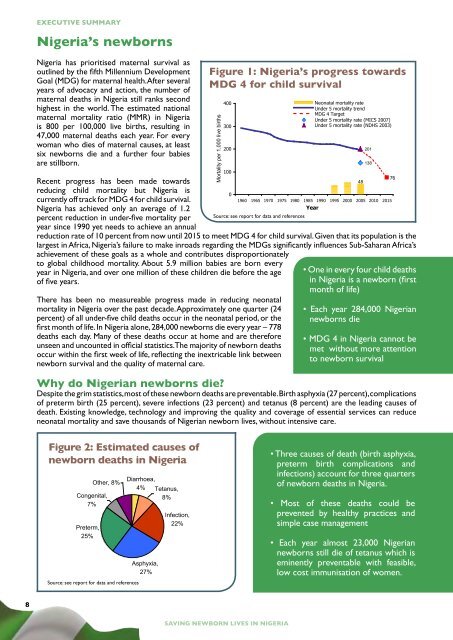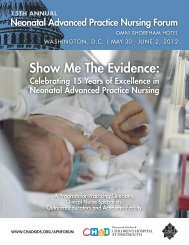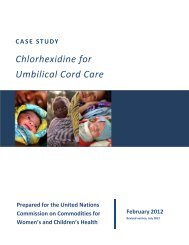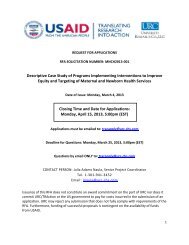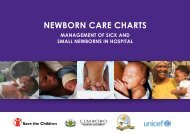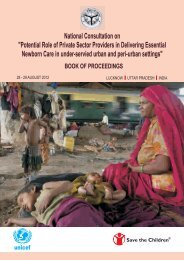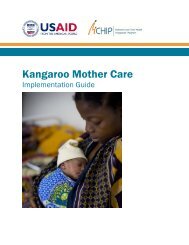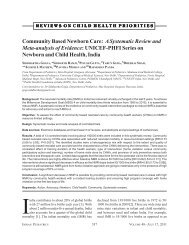situation action plan - nigeria.pdf - Healthy Newborn Network
situation action plan - nigeria.pdf - Healthy Newborn Network
situation action plan - nigeria.pdf - Healthy Newborn Network
- No tags were found...
You also want an ePaper? Increase the reach of your titles
YUMPU automatically turns print PDFs into web optimized ePapers that Google loves.
EXECUTIVE SUMMARYNigeria’s newbornsNigeria has prioritised maternal survival asoutlined by the fifth Millennium DevelopmentGoal (MDG) for maternal health. After severalyears of advocacy and <strong>action</strong>, the number ofmaternal deaths in Nigeria still ranks secondhighest in the world. The estimated nationalmaternal mortality ratio (MMR) in Nigeriais 800 per 100,000 live births, resulting in47,000 maternal deaths each year. For everywoman who dies of maternal causes, at leastsix newborns die and a further four babiesare stillborn.Recent progress has been made towardsreducing child mortality but Nigeria iscurrently off track for MDG 4 for child survival.Nigeria has achieved only an average of 1.2percent reduction in under-five mortality peryear since 1990 yet needs to achieve an annualreduction rate of 10 percent from now until 2015 to meet MDG 4 for child survival. Given that its population is thelargest in Africa, Nigeria’s failure to make inroads regarding the MDGs significantly influences Sub-Saharan Africa’sachievement of these goals as a whole and contributes disproportionatelyto global childhood mortality. About 5.9 million babies are born everyyear in Nigeria, and over one million of these children die before the ageof five years.There has been no measureable progress made in reducing neonatalmortality in Nigeria over the past decade. Approximately one quarter (24percent) of all under-five child deaths occur in the neonatal period, or thefirst month of life. In Nigeria alone, 284,000 newborns die every year – 778deaths each day. Many of these deaths occur at home and are thereforeunseen and uncounted in official statistics. The majority of newborn deathsoccur within the first week of life, reflecting the inextricable link betweennewborn survival and the quality of maternal care.Figure 1: Nigeria’s progress towardsMDG 4 for child survivalMortality per 1,000 live births400300200100Mortality per 1,000 live births0Neonatal mortality rateUnder 5 mortality trendMDG 4 TargetUnder 5 mortality rate (MICS 2007)Under 5 mortality rate (NDHS 2003)1960 1965 1970 1975 1980 1985 1990 1995 2000 2005 2010 2015YearSource: see report for data and references4848201138• One in every four child deathsin Nigeria is a newborn (firstmonth of life)• Each year 284,000 Nigeriannewborns die• MDG 4 in Nigeria cannot bemet without more attentionto newborn survivalWhy do Nigerian newborns die?Despite the grim statistics, most of these newborn deaths are preventable. Birth asphyxia (27 percent), complicationsof preterm birth (25 percent), severe infections (23 percent) and tetanus (8 percent) are the leading causes ofdeath. Existing knowledge, technology and improving the quality and coverage of essential services can reduceneonatal mortality and save thousands of Nigerian newborn lives, without intensive care.76Figure 2: Estimated causes ofnewborn deaths in NigeriaPreterm,25%Other, 8%Congenital,7%Source: see report for data and referencesDiarrhoea,4% Tetanus,8%Asphyxia,27%Infection,22%• Three causes of death (birth asphyxia,preterm birth complications andinfections) account for three quartersof newborn deaths in Nigeria.• Most of these deaths could beprevented by healthy practices andsimple case management• Each year almost 23,000 Nigeriannewborns still die of tetanus which iseminently preventable with feasible,low cost immunisation of women.8SAVING NEWBORN LIVES IN NIGERIA


